I have two identical 48 V switched power supplies, both of which can deliver the same current of, say, 4 A.
Can I connect them in series to get 96 V at 4 A? Is this something possible / recommended?
I have two identical 48 V switched power supplies, both of which can deliver the same current of, say, 4 A.
Can I connect them in series to get 96 V at 4 A? Is this something possible / recommended?
Some gotchas here:
This will only work if the outputs of the 48V supplies are 'floating'. Many power supplies earth the low side (negative) output - you cannot put them in series since the 'bottom' supply would have both its positive and negative rails at earth potential (i.e. a short circuit).
In the event of overload (excessive current), whichever power supply has the lower threshold will collapse first and bring down the other power supply rail, even if it has a naturally higher overload threshold.
The two power supplies won't start up exactly the same way (turn-on time, rise time, etc.) so you won't have a monotonic ramp from 0 to 96V.
This can't be answered in general without knowing the details of your power supplies. Some will accept being connected in series without problems, some might not and start to become unstable. To be sure, you need a manual, ideally with a section like this:

(Source; Note that this same supply will not accept being operated in parallel with another one, which is o.k. for other supplies.)
Two common gotchas for series-connected supplies:
If you short the output, the two supplies are connected back-to-back, with a reversed polarity. Think of it this way: One supply is a bit stronger than the other one, and it will force its output voltage onto the other supply, upside down. Even some common conditions, like charging a capacitor connected as a load to the supplies, will look like a temporary short circuit.
48 V is considered a safe, low-voltage. The outputs of your supplies may be designed such that they rely on this fact. Connecting your supplies in series will yield a dangerously high voltage. Aside from posing a danger to the user, there may be components in your supplies that won't accept the increased voltage.